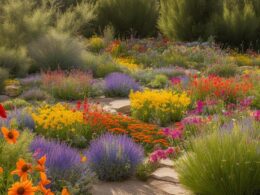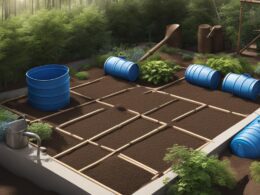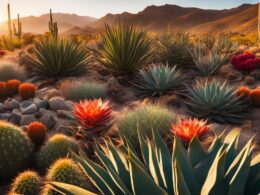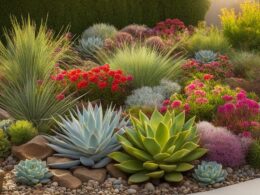In this article, we will explore the principles of desert landscape design and how you can create an outdoor space that is not only visually stunning but also sustainable. Designing a desert landscape requires careful consideration of various factors, from water management to space utilization. By following the principles discussed here, you can transform your outdoor space into a vibrant desert oasis that harmonizes with the arid environment.
Key Takeaways:
- Desert landscape design requires careful consideration of visual layering, space utilization, water management, and design principles.
- Gather inspiration from online images and local gardens when starting your design, considering the function and available space.
- Design principles such as unity, flow, balance, scale, and focal points play a crucial role in creating a cohesive and visually pleasing desert garden.
- Design elements like space delineation, repetition, shape, form, texture, visual layering, focal points, and color contribute to the overall aesthetic of a desert landscape.
- By incorporating water management strategies and selecting appropriate plants, you can create a sustainable and vibrant desert oasis in your outdoor space.
Starting Out with Your Design
When embarking on your desert landscape design journey, it’s important to start with a solid plan. Gathering inspiration from various sources can help you visualize the possibilities for your outdoor space. Browse through online images, visit local gardens, and take note of elements that appeal to you. Let these inspirations guide you as you design your own desert oasis.
Functionality is a key aspect to consider when designing your space. Determine how you want to use the area – whether it’s for play, relaxation, entertaining guests, or even growing your own food. This will help you make informed decisions about the layout, furniture, and plants that will best serve your needs. By understanding the function you desire, you can create a space that is not only visually appealing but also practical.
Another important consideration is the available space and its unique characteristics. Take into account the patterns of sunlight and wind in your area. This will help you position various elements of your design strategically. Additionally, consider incorporating a plan for water management. Given the arid environment, using techniques like drip irrigation or rainwater harvesting can help you conserve water and ensure sustainable growth for your plants.
Seek Inspiration:
- Explore online images of desert landscapes
- Visit local gardens and take notes of appealing features
- Find inspiration in the natural beauty of the desert
Design for Function:
- Consider how you want to use the outdoor space
- Plan for play areas, relaxation zones, or food production
- Design with the specific needs of your household in mind
Utilize Space and Water Wisely:
- Evaluate the effects of sunlight and wind on your space
- Position elements to maximize natural light and minimize wind impact
- Implement water management techniques like drip irrigation or rainwater harvesting
By starting out with a clear vision, considering the function of your space, and paying attention to the unique characteristics of your environment, you can lay the foundation for a successful desert landscape design. Stay inspired, be mindful of water management, and let your creativity flourish as you create a beautiful and functional outdoor oasis.
Design Principles for Desert Gardens
Design principles are essential in creating a visually captivating and harmonious desert garden. By incorporating these principles into your design, you can transform your outdoor space into a tranquil oasis that blends seamlessly with the arid environment. Here are some key principles to consider:
- Unity: Achieve unity by carefully selecting plants that thrive in desert conditions and arranging them in a way that creates a cohesive and harmonious look. Pay attention to the overall design and ensure that elements blend together seamlessly.
- Flow: Guide visitors through your garden by creating a well-thought-out flow. Consider the pathways, seating areas, and focal points that encourage exploration and create a journey through the space.
- Balance: Achieve visual balance by distributing elements throughout the garden in a way that feels harmonious. Consider the size, shape, and color of plants, as well as the placement of hardscape features.
- Scale: Ensure that the size of elements within your garden is appropriate for the space. Consider the proportionality of plants, hardscape structures, and focal points to create a balanced and visually pleasing design.
- Focal Points: Create visual interest and draw attention to specific areas of your garden with focal points. This could be a unique plant species, a water feature, or a sculpture. Focal points create a sense of intrigue and add depth to your design.
By incorporating these design principles into your desert garden, you can create a space that is not only visually stunning but also harmonious with the natural surroundings. Let these principles guide your decision-making process and transform your outdoor space into a sustainable and vibrant oasis.
Creating Unity Through Plant Selection
One of the key aspects of achieving unity in your desert garden design is the careful selection of plants. Consider choosing plants that are native to the region or those that are well-suited to the arid climate. By selecting plants with similar growth habits, colors, or textures, you can create a cohesive and unified look. Additionally, incorporating plants that bloom at different times throughout the year ensures that your garden remains visually appealing no matter the season.
Establishing Flow and Creating a Journey
Flow is an important element to consider when designing a desert garden. By creating a well-defined pathway or series of pathways, you can guide visitors through the space and encourage exploration. Along the path, incorporate seating areas or small nooks where visitors can pause and appreciate the beauty of the garden. Introduce surprises along the way, such as hidden focal points or water features, to create a sense of excitement and anticipation.
Achieving Balance and Scale
Balance and scale are essential for creating a visually pleasing desert garden. Balance can be achieved by evenly distributing plants, hardscape elements, and focal points throughout the space. Consider the size, shape, and color of each element to ensure they work harmoniously together. Scale, on the other hand, refers to the appropriate size of elements in relation to the space. Select plants and features that are proportionate to the overall size of your garden, creating a balanced and cohesive design.
Design Elements for Desert Landscapes
In desert landscape design, the careful selection and arrangement of design elements play a vital role in creating a visually stunning and harmonious outdoor space. By incorporating elements such as space delineation, repetition, shape, form, texture, visual layering, focal points, and color, you can transform your desert garden into a captivating oasis.
One effective way to create a sense of structure in your desert landscape is through space delineation. Utilize hardscape elements like walls, pathways, or raised beds to define different areas within your garden. This not only helps to organize the space but also adds visual interest and depth to the overall design.
Repetition is another key element that brings unity to your desert landscape. By repeating plants, colors, textures, and forms throughout the garden, you create a cohesive and balanced aesthetic. This repetition can be achieved through strategic placement of similar plants or by incorporating consistent color schemes or patterns.
The shape, form, and texture of the plants and hardscape elements in your desert garden are essential in creating visual appeal. Consider using plants with distinct shapes and forms to add interest and variety. Select plants with different textures, such as spiky or smooth, to create contrast and enhance the overall visual experience.
Visual layering is an effective technique in desert landscape design that adds depth and dimension to your space. By incorporating plantings of varying heights and groupings, you can create a layered effect that draws the eye and creates a sense of intrigue. This can be achieved by arranging plants from tallest in the back to shortest in the front or by incorporating vertical elements like trellises or arbors.
Focal points are essential design elements that guide the eye and create visual interest. Consider incorporating unique plants, sculptures, or water features as focal points in your desert garden. These eye-catching elements serve as the centerpieces of your design, drawing attention and adding a focal point to the overall composition.
Lastly, color plays a significant role in desert landscape design. Warm tones like yellows, oranges, and reds can create a sense of warmth and vibrancy, while cooler tones like blues and purples can bring a soothing and calming atmosphere. Consider using a combination of warm and cool colors strategically throughout your garden to enhance the overall aesthetic and create visual impact.
By incorporating these design elements into your desert landscape, you can create a visually appealing and harmonious outdoor space that reflects the beauty and uniqueness of the arid environment.
How Can I Incorporate Native Plants into Desert Landscape Design?
Incorporating native plants into desert landscape design can be achieved by consulting a master native plant landscaping expert. By choosing plants that are naturally adapted to the arid environment, you can create a sustainable and low-maintenance garden that flourishes in the harsh desert climate.
Conclusion
Designing a desert garden involves careful planning and consideration of various factors. By incorporating the principles and elements discussed in this article, you can create a sustainable and vibrant outdoor oasis. With the right approach, your desert landscape can seamlessly blend with the arid environment, enhancing the overall aesthetic of your outdoor space.
To achieve a sustainable design, it’s crucial to implement water management strategies. Consider utilizing drip irrigation or rainwater harvesting to efficiently utilize water in your garden. By conserving water and designing your landscape with water efficiency in mind, you can create a desert garden that thrives in the arid conditions.
Additionally, applying the design principles discussed in this article will help you create a cohesive and visually appealing desert landscape. Focus on achieving unity through careful plant selection and spatial design, and maintain balance and harmony through proportionate elements. Incorporate focal points to draw attention and create visual interest, and utilize color strategically to enhance the overall design.
In conclusion, with the right planning and implementation, you can transform your outdoor space into a sustainable and beautiful desert garden. By embracing the unique characteristics of the desert environment and considering water management, design principles, and suitable elements, you can create an outdoor oasis that brings joy and tranquility to your home.












